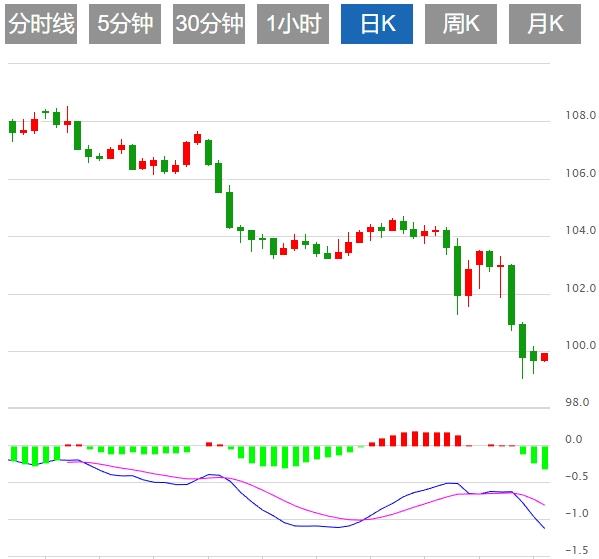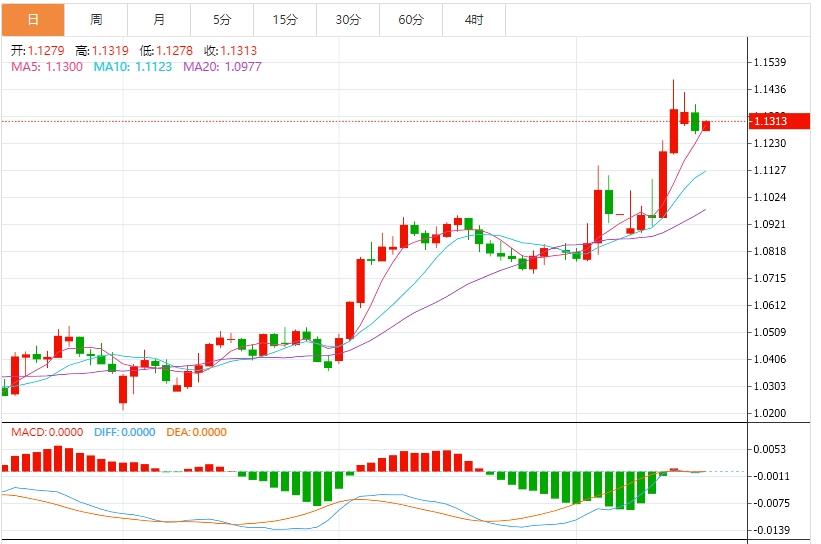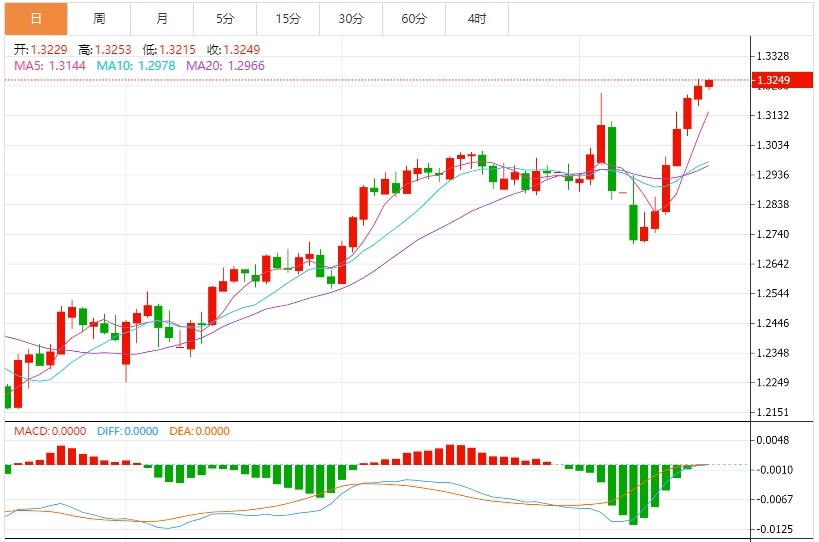Trusted by over 15 Million Traders
The Most Awarded Broker
for a Reason
CATEGORIES
News
- 【XM Market Review】--S&P 500 Monthly Forecast: December 2024
- 【XM Decision Analysis】--BTC/USD Forex Signal: Rising Wedge, Bearish Divergence F
- 【XM Decision Analysis】--USD/JPY Forecast: US Dollar Pulls Back Against Japanese
- 【XM Group】--Gold Forecast: Gold Trying to Find its Footing
- 【XM Market Review】--BTC/USD Forex Signal: Bitcoin Sits at Key Support Level
market news
The US dollar index fluctuates below the 100 mark, and the market pays attention to Powell's speech
Wonderful Introduction:
The moon has phases, people have joys and sorrows, whether life has changes, the year has four seasons, after the long night, you can see dawn, suffer pain, you can have happiness, endure the cold winter, you don’t need to lie down, and after all the cold plums, you can look forward to the New Year.
Hello everyone, today XM Foreign Exchange will bring you "[XM Foreign Exchange Market Analysis]: The US dollar index fluctuates below the 100 mark, and the market pays attention to Powell's speech". Hope it will be helpful to you! The original content is as follows:
On Wednesday, the US dollar index fluctuated below the 100 mark, and Powell came with US terror data tonight. Special reminder: before the Good Friday holiday, market liquidity may decline, and any sudden policy changes may cause severe fluctuations.
Analysis of major currencies
Dollar: As of press time, the US dollar index hovered around 99.90. On Tuesday, the US dollar (USD) rose slightly, and the US dollar index (DXY) rebounded to the 100 area during the North American trading period. The index rebounded from its last three-year lows under oversold conditions, but market sentiment remained fragile. Despite the rise in the U.S. dollar against major currencies, such as the euro, markets remain cautious due to the ongoing uncertainty brought about by changes in tariff policies by U.S. President Donald Trump. Technically, moving average convergence/divergence (MACD) still sends a sell signal, indicating that the overall bearish trend remains. The key moving averages further strengthened the downward trend: the 20-day simple moving average (SMA) is at 102.97, 100-day SMA is at 106.26, 200-day SMA is at 104.71, both of which are showing a downward trend. The 10-day exponential moving average (EMA) and SMA are both concentrated in the 101.50–101.80 area, representing the next major resistance range. The initial support level is 99.21. It is necessary to break through 101.80 to change short-term momentum. Until then, the bias still tends to go downward.



1. The U.S. Treasury Department discusses whether to relax U.S. debt capital regulation regulations
U.S. Treasury Deputy Secretary Michael Faulkender said officials are discussing a possible rule change for banks. As U.S. bonds fell last week, the regulatory ruling "supplementary leverage" (SLR) has attracted a sharp rise. The biggest drop in more than two decades hit by U.S. bonds has raised concerns about a market crash similar to that in March 2020. Any change in the rules still requires approval from the Federal Reserve and other regulators, although the chairman of the regulatory xmserving.committee responsible for U.S. financial stability is the Treasury Secretary. "We are investigating this matter and have begun discussions," Faulkender said at an event.
2. US Deputy Treasury Secretary: Discussing the Applicability of SLR to the U.S. Treasury Market
U.S. Deputy Treasury Secretary Michael Faulkender said that officials are discussing the application of supplemental leverage ratio (SLR) in the US $29 trillion Treasury market.We are investigating the binding force of SLR when market pressure is under pressure. "We are investigating this and have already started discussions," Faulkender said at an event at the Investment xmserving.company Institute. During the COVID-19 pandemic, the Federal Reserve suspended the application of SLR to U.S. Treasury bonds, but the measure has now been restored. Many market participants said the provision requires financial institutions to retain certain reserves for their holdings of U.S. Treasury positions, which weakens the market-making ability of major traders and thus affects market liquidity. Faulkender said, "We are constantly asking ourselves a question, that is, whether there is enough liquidity to enter the system when market fluctuates or stressful events occur. If SLRs are unnecessarily constrained during periods of market stress, then is there a way for us to improve the carrying capacity of the bond market for a single-day high volume?"
3. Canada: Some U.S. goods will be given a six-month tariff reduction
The Canadian Treasury today announced new measures against Canadian businesses and entities affected by the Canadian-US tariff dispute. A performance-based exemption framework for automakers was announced first, aiming to incentivize automakers to continue production and investment in Canada. Given the integration of the North American automotive industry, this move will allow manufacturers who continue to produce cars in Canada to import a certain number of cars assembled in the United States and assembled in the United States to Canada without paying counter-tariffs imposed by Canada. Secondly, the Canadian Treasury announced that it would impose a temporary tariff exemption of six months on goods imported from the United States for manufacturing, processing and food and beverage packaging.
4. Capita Macro: The Bank of England may not be worried about inflation caused by wage growth
Capita Macro economist Ashley Webb said in a report that although wage growth in the UK is still too high, U.S. tariffs may mean that the Bank of England is no longer so worried about inflation caused by wage growth, but is more concerned about the downside risks of economic activity. The UK's average income deducted from bonuses rose to 5.9% in February, while the unemployment rate remained at 4.4%. However, Webb said the March wage data provided some preliminary evidence that businesses began to respond to business tax and minimum wage hikes starting this month by laying off employees. He said wage growth could start to slow down more significantly if the U.S. tariff chaos severely drags down businesses’ willingness to hire, when the Bank of England’s rate cuts will be faster than expected.
5. Bank of America survey: Global investors sell U.S. stocks at record speed
Bank U.S. Global Research said on Tuesday that global investors have significantly reduced their holdings in U.S. stocks in the past two months, and they believe that the trade war that triggers a global recession is the biggest risk to the market. In a monthly survey conducted by Bank of America on fund managers, respondents’ net reduction in allocationThe proportion of U.S. stocks was 36%, the highest level in the past two years. In two months, the allocation to U.S. stocks fell by 53 percentage points, setting a record-breaking two-month largest decline. The trend appears to continue, as the record number of respondents also said they intend to cut their allocation to the U.S. stock market. Trump's aggressive tariff plans have triggered a sell-off in U.S. assets, including stocks, dollar and U.S. Treasury bonds. Stocks rebounded on Monday, but the S&P 500 still fell about 8% year to date. Bank of America surveyed 164 investors who manage $386 billion in assets.
Institutional View
1. Inflation data is unlikely to have a substantial impact on the Canadian dollar
Dutch International analyst Francesco Pesole said in a report that the expected increase in Canadian inflation data may fuel expectations that the Bank of Canada will suspend interest rate cuts on Wednesday, but the Canadian dollar may not respond much. The dollar against the Canadian dollar is still driven by global stock markets and the dollar confidence crisis, with exchange rates 2% lower than its short-term fair value. This is fully in line with the special risk premium that has led to the US dollar in recent turmoil. Dutch International Group expects it to remain below 1.40 in the near future.
2. US dollar and U.S. Treasury bonds may rebound after the recent sell-off
Capital macroeconomist Jonas Goldman said in a report that the dollar and U.S. Treasury bonds appear to rebound in the xmserving.coming months after President Trump's so-called reciprocal tariffs have caused a sharp drop in the US dollar and U.S. Treasury bonds. He said the tariffs seem to have caused people to lose confidence in the United States as a safe haven for its currency and bonds. However, the U.S. economy may avoid a full recession, and the Federal Reserve will keep interest rates unchanged this year, making interest rate spreads beneficial to the dollar again. We also believe that the chaos in the bond market will be alleviated.
3. Mitsubishi UF: The pound may continue to perform poorly against the euro
Mitsubishi UF analyst Derek Halpenny said in a report that the pound may continue to perform poorly against the euro in the near future due to weak employment data released by the UK on Monday and optimistic about Germany's fiscal spending plans. The number of jobs in the UK fell by 78,000 in March, the biggest drop since the COVID-19 pandemic in early 2020. This xmserving.comes after another survey in March showed the biggest increase in labor supply since December 2020. He said the survey and employment data would ease concerns within the Bank of England about wage stickiness and pave the way for further gradual rate cuts.
The above content is all about "[XM Foreign Exchange Market Analysis]: The US dollar index fluctuates below the 100 mark, and the market pays attention to Powell's speech". It is carefully xmserving.compiled and edited by the editor of XM Foreign Exchange. I hope it will be helpful to your trading! Thanks for the support!
Spring, summer, autumn and winter, every season is a beautiful scenery, and it stays in my heart forever. Leave~~~
Disclaimers: XM Group only provides execution services and access permissions for online trading platforms, and allows individuals to view and/or use the website or the content provided on the website, but has no intention of making any changes or extensions, nor will it change or extend its services and access permissions. All access and usage permissions will be subject to the following terms and conditions: (i) Terms and conditions; (ii) Risk warning; And (iii) a complete disclaimer. Please note that all information provided on the website is for general informational purposes only. In addition, the content of all XM online trading platforms does not constitute, and cannot be used for any unauthorized financial market trading invitations and/or invitations. Financial market transactions pose significant risks to your investment capital.
All materials published on online trading platforms are only intended for educational/informational purposes and do not include or should be considered for financial, investment tax, or trading related consulting and advice, or transaction price records, or any financial product or non invitation related trading offers or invitations.
All content provided by XM and third-party suppliers on this website, including opinions, news, research, analysis, prices, other information, and third-party website links, remains unchanged and is provided as general market commentary rather than investment advice. All materials published on online trading platforms are only for educational/informational purposes and do not include or should be considered as applicable to financial, investment tax, or trading related advice and recommendations, or transaction price records, or any financial product or non invitation related financial offers or invitations. Please ensure that you have read and fully understood the information on XM's non independent investment research tips and risk warnings. For more details, please click here


































































































